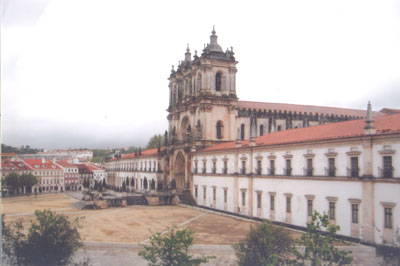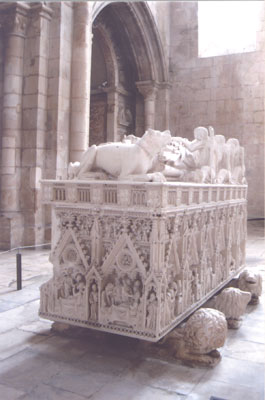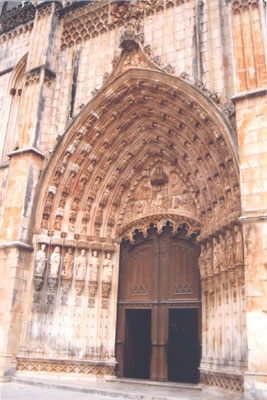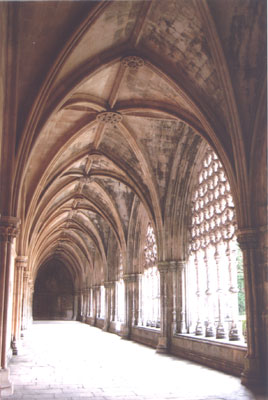Of love and war — two Portuguese monasteries
This item appears on page 59 of the November 2012 issue.
(1 of 2 on Portugal)
Two of Portugal’s most remarkable monasteries — Alcobaça and Batalha — lie within 12 miles of each other 80 miles north of Lisbon. One celebrates a tragic love, and the other, victory in war.
Alcobaça is one of the earliest Gothic monuments built in Portugal. Founded in 1153 by Afonso Henriques, the first Portuguese king, it was given to Bernard of Clairvaux, a French Cistercian monk. One of the great spiritual leaders of the 12th century, Bernard died soon thereafter, but his monks settled there in what was to become one of the greatest Cistercian monasteries in Europe.
Much remains from the earliest days of the monastery, although there have been additions over the centuries, notably the 18th-century Baroque facade surrounding the church’s main western Gothic doorway and rose window.
Tragic lovers
Within, at the east end of the austere nave, is the highlight of this magnificent church: two tombs, one in each of the transepts. These hold the remains of two tragic lovers: King Pedro (1320-1367) and Inês Peres de Castro (1323-1355).
Pedro, already married, fell in love with Inês, who was later assassinated on the orders of Pedro’s father, the (then) king Afonso IV. Afonso IV considered Inês and her children by Pedro as a threat to the legitimate heirs to the Portuguese throne.
The carvings on the two 14th-century Gothic tombs are elaborate. Pedro’s, which rests on lions, portrays incidents from his life with Inês, including her murder. Inês’ tomb rests on the stooped bodies of her murderers.
Other highlights not to miss are the 13th-century monks’ refectory, with a high vaulted ceiling and an unusual pulpit embedded in one wall, the kitchen with an open fireplace and an enormous chimney above it, and the 16th-century Hall of Kings, with statues of many of Portugal’s monarchs.
The 18th-century tiled wall in this hall tells the story of the 12th-century reconquest of Portugal from the North African Moors and the building of this monastery in the late 12th and early 13th centuries.
Fulfillment of a vow
If Alcobaça is considered one of Portugal’s earliest Gothic masterpieces, Batalha is considered its finest architectural achievement. Its construction was begun in 1386 by King João I in fulfillment of a vow to build a monastery if the Portuguese defeated the Castilian army from Spain. The battle of Aljubarrota was fought in August 1385, the Spanish were routed, and the monastery was built three miles from the battle site.
A Gothic west doorway crowded with apostles, evangelists, prophets and angels leads into an interior thick with tall columns. Close to this entrance is one of the monastery’s highlights, the Founder’s Chapel, built as a mausoleum by João I for his family.
João I and his wife, Philippa of Lancaster (daughter of the English John of Gaunt and granddaughter of Edward III of England), lie atop a joint tomb surrounded by the tombs of many of their children, including Prince Henry the Navigator.
It was João I who ushered in Portugal’s centuries of greatness, with Portuguese fleets sailing the globe on voyages of trade and exploration.
The same João built the beautiful Royal Cloister. The stone ornamentation filling in the arcades was added a century later by Manuel I, his great grandson.
Visitors must leave the monastery to reenter the Unfinished Chapels abutting the east end of the monastery church. King Duarte (1391-1438), João’s son, wanted a chapel as a resting place for his own family that was similar to the Founder’s Chapel. It was never completed, although Duarte’s grandson, Manuel I, resumed work in the early 16th century, adding the Great Portal in the elaborate style called Manueline. It incorporates rope coils, cornstalks, artichokes and even a parade of snails.
But Manuel, too, abandoned the project, preferring to direct his money to the Jerónimos Monastery in Lisbon, where he now lies. Duarte and his wife, Leonor of Aragon, rest in tombs under the open sky in the still-unfinished chapel.
Side trip to Óbidos
On the excursion to Alcobaça and Batalha that my husband and I made in April 2012, we also visited the lovely, small town of Óbidos, located on a hilltop surrounded by a fortified wall. The castle at the edge of town is now a pousada, an elegant inn, where visitors can play “king for a night.”
Óbidos has both Roman (the settlement was called Eburobrittium) and Moorish roots. It was reconquered from the Moors by Afonso Henriques in 1148.
Today, visitors amble along its cobblestone streets and alleyways, look at the whitewashed houses with blue trim, and sample the town’s
ginjinha, a potent sour cherry liqueur. We did the same.
If you go…
We toured with a superb small company, Lux Invicta (Alcobaça, Portugal; phone +351 262 588 269 or +351 966 938 401). It offers both multinight excursions and day excursions.
Among the multiday excursions is a 3-night “Mysteries of the Templars,” which visits sites associated with this crusading military order. Another tour, “Nine Centuries, Nine Castles,” visits Portuguese castles from Monsaraz in the south to Guimarães in the north over seven nights. This is the tour I’d like to do on my next trip to Portugal.
Among the day trips offered are one to the 140-year-old Sanguinhal Vineyard, including a tasting of seven wines; one to the Mira de Aire caves, the most extensive in Portugal, and one to Alcobaça, Batalha and Óbidos, which is the one we took in April.
All tours are private and in air-conditioned vans that can seat up to nine passengers. Prices for day trips range from €58 to €95 (about $73 to $119) per person, depending on the number of people in the van, and include both driver and guide. Lunch is not included. Service is door to door.




